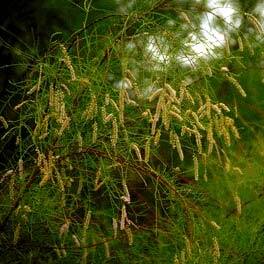Small trees or shrubs, sometimes dioecious, mostly evergreen, papillose, pilose or glabrous, mostly halophytic and xerophytic. Leaves alternate, small, exstipulate, mostly sessile and scale-like. Inflorescence a slender bracteate raceme, spike, or cluster of racemes, or flowers solitary. Flowers actinomorphic, small, commonly with a fleshy nectary disc. Sepals 4 or 5, rarely 6, free or connate toward base, imbricate. Petals as many as sepals, free. Stamens as many as sepals or twice as many, or more numerous in 5 bundles, free or basally connate, dehiscing by longitudinal slits. Ovary superior, mostly of 3 or 4 carpels, unilocular but sometimes with deeply intruding placentas; styles free or connate. Ovules 2 to many; placentation parietal or basal. Fruit a small loculicidal capsule. Seeds with long hairs; embryo straight; endosperm scanty or absent.
Xerophytic or halophytic shrubs or small trees, with slender branches and reduced subulate or scale-like, alternate, exstipulate, glandular-punctate leaves. Flowers in racemes or spikes or solitary, small, usually bisexual, regular, hypogynous. Calyx and corolla distinct, 5–4-merous, imbricate, free. Disk present. Stamens as many as petals and alternate with them, or twice as many in two alternating whorls; filaments mostly free, sometimes ± united, inserted on the disk; anthers 2-thecous, opening by longitudinal slits. Ovary superior, 1-locular; carpels 3–4; placentas 2–5, basal or parietal, each with 2 or more erect anatropous ovules; styles as many as carpels, free or united below or stigmas sessile. Fruit a capsule. Seeds ? with long hairs, with or without endosperm; embryo straight
Shrubs or trees [subshrubs], usually halophytes, rheophytes, or xerophytes. Leaves alternate, scalelike [subulate], small; stipules absent. Inflorescences simple or compound racemes usually equal or more in number to petals, distinct [connate basally or fasciculate], often attached to fleshy nectar disc; pistil (2–)3–4(–5)-carpellate; ovary 1-locular, sometimes almost plurilocular, ovules 2+ per placenta, anatropous, bitegmic; placentation parietal, basal, or parietal-basal; styles [2–]3–4[–5] [absent, stigmas sessile]. Fruits capsular, dehiscence loculicidal. Seeds comose at one end [hairy overall]; embryo straight; endosperm absent [scanty, starchy]; thin perisperm often present.
Ovary superior, 1-celled, with parietal or basal placentas; styles 3–4, free or united at the base; ovules numerous, ascending
Stamens hypogynous, 5–10, free or connate at the base; anthers 2-celled, opening by longitudinal slits
Flowers very small, actinomorphic, usually hermaphrodite, in slender catkin-like spikes or racemes
Seeds with or without endosperm, with a tuft of hairs at the apex or all round; embryo straight
Shrubs or trees, with slender branches and small scale-like alternate leaves; stipules absent
Petals as many as the sepals, free
Sepals 4–6, imbricate, free
Fruit a capsule
Disk present

